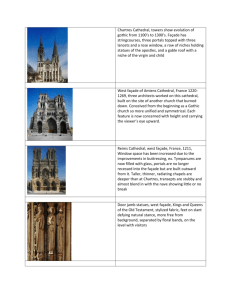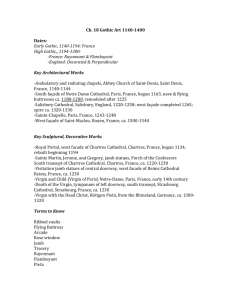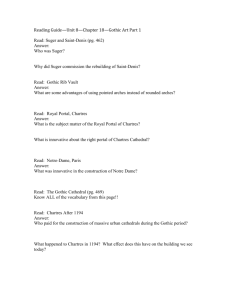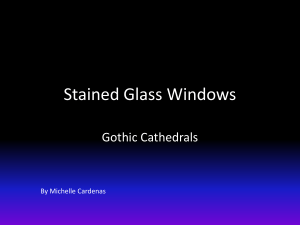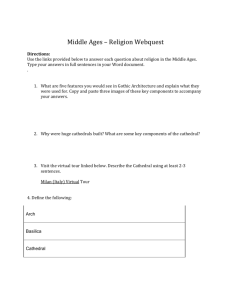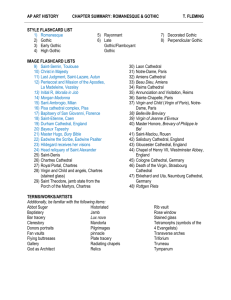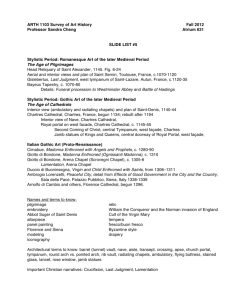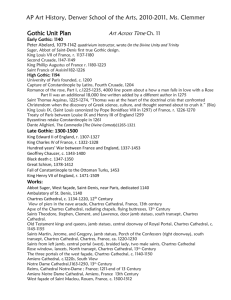apah - chapter 18-2 - Point Loma High School
advertisement
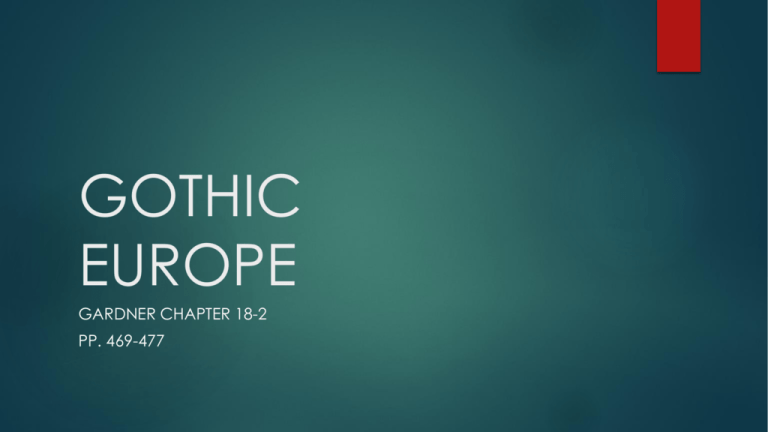
GOTHIC EUROPE GARDNER CHAPTER 18-2 PP. 469-477 THE GOTHIC CATHEDRAL The great cathedrals erected throughout Europe in the 12th and 13th centuries are the enduring symbols of the Gothic age Towering structures These buildings are a unique expression of medieval faith The “recipe” for Gothic cathedrals = 1. rib vaults w/pointed arches 2. flying buttresses 3. stained-glass windows CHARTRES, AFTER 1194 Aerial view of Chartres Cathedral, France, as rebuilt after 1194 Construction of urban cathedrals often lasted for decades/centuries Financing depended on collections and public contributions -> lack of funding and unforeseen events often interrupted building Rebuilt/post 1194 Chartres is considered the first High Gothic building The Chartres plan, in which a single square in each aisle flanks a single rectangular unit in the nave with a four part vault, became the norm for High Gothic Interior of Chartres Cathedral -> Chartres becomes a model for High Gothic churches -> tripartite elevation of nave arcade, triforium, and clerestory w/extremely tall stained-glass windows CHARTRES, STAINED GLASS Virgin and Child and angels, detail of a window in the choir of Chartres Cathedral, France, ca. 1170, 16” full height Purpose of these windows was not to illuminate the interior w/bright sunlight but to transform light into lux nova/new light Frontal composition of Mary and Child -> she is the beautiful, young, rather worldly Queen of Heaven -> compare this w/the Theotokos images in Byzantine art – severe and aloof STAINED-GLASS WINDOWS Detail of stained-glass rose window, north transept Chartres Cathedral, France, ca. 1220 Stained-glass windows are almost synonymous w/ Gothic architecture These do not conceal walls -> they replace them -> transmit light instead of reflect light Transmitting the light of God into the hearts of the faithful Costly and labor-intensive to produce CHARTRES, SOUTH TRANSEPT Saints Martin, Jerome, and Gregory, jamb statues, Porch of the Confessors, south transept, Chartres Cathedral In contrast to the Royal Portal statues, the south-transept statues have individual personalities and turn slightly to left or right, breaking the rigid vertical lines of 12th century predecessors (right) Saint Theodore, jamb statue, Porch of the Martyrs, south transept, Chartres Cathedral, France, ca. 1230 Although the statue of Saint Theodore is still attached to a column, the setting no longer determines the pose -> saint is portrayed swinging out one hip, as in Greek statuary AMIENS CATHEDRAL Interior of Amiens Cathedral, Amiens, France, begun 1220 Amiens elevation derived from the High Gothic formula of Chartres -> even more elegant -> number and complexity of the lancet windows in clerestory and triforium are greater French Gothic obsession with constructing taller churches Self sustaining skeletal architecture -> nave vaults rise 144 ft. -> choir vault resembles a canopy suspended from bundled masts -> sunlight entering from clerestory windows creates an effect of buoyant lightness West façade of Amiens Cathedral, France, begun 1220 Deep piercing of the Amiens façade left few surfaces for decoration -> but sculptors covered remaining ones w/colonettes, pinnacles, and rosettes that nearly dissolve the structure’s solid core Bearded, benevolent Gothic image of Christ BEAU DIEU Christ (Beau Dieu), trumeau statue of central doorway, west façade of Amiens Cathedral, France, ca. 12201235 Fully modeled figure -> massive drapery folds cascading from waist Beau Dieu = Beautiful God -> a kindly figure who blesses all who enter the cathedral -> tramples a lion and dragon symbolizing the evil forces in the world -> image gives humankind hope in Salvation REIMS CATHEDRAL West façade of Reims Cathedral, Reims, France, ca. 1225-1290 High Gothic style is carried further architecturally and sculpturally Kings’ gallery of statues above the rose windows -> taller/more ornate frames Openings in the towers are taller and more decorated Pointed arch frames the rose window Stained-glass windows replace stone relief sculptures in the tympana (right) Annunciation and Visitation, jamb statues of the central doorway, west façade, Reims Cathedral, France, ca. 1230-1255 Reims jamb statues are detached from the columns -> classical naturalistic style and contrapposto postures -> legs bend, knees press through garments, arms in motion SAINT-CHAPELLE, PARIS Interior of the upper chapel, SaintChapelle, Paris, France, 1243-1248 Wall dissolving High Gothic architectural style Masterpiece of the RAYONNANT(radiant) style of the High Gothic age -> the style of royal Parisian court of King Louis IX ¾’s of the structure is stained-glass -> each window is 49 feet high and 15 feet wide
